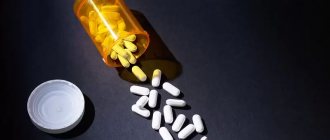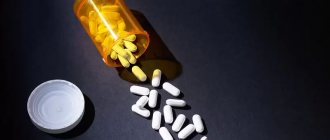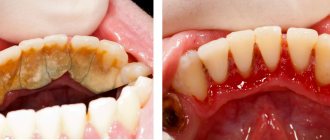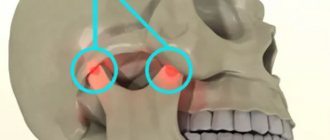Drug poisoning is a fairly common situation. Many people have an already formed habit of reaching for medications for any ailment, bypassing a doctor’s appointment. This problem is associated with the impossibility of obtaining medical care in a short time, and with the over-the-counter dispensing of many medications in pharmacies. Typically, the reasons for taking medications without a prescription from a specialist are headaches, gastrointestinal tract disorders, spasms, back and joint pain.
Poisoning occurs due to a number of factors:
- exceeding the recommended dosage;
- uncontrolled use of the prescribed drug. For example, taking a dose for several days at a time;
- taking a combination of incompatible drugs - two drugs, and/or alcohol incompatible with the drug;
- use of expired drugs;
- errors in choosing a medication.
Drug intoxication can lead to dangerous consequences for life and health. Therefore, for any ailments that appear while taking medications, consult a doctor immediately.
Drug poisoning. Uncontrolled use of medications is a common cause of poisoning.
Content:
- general information
- Zoloft overdose: how many tablets cause it
- Zoloft overdose: symptoms
- Zoloft overdose: what to do
- Withdrawal syndrome
Few people know that the popular antidepressant Zoloft in Russia has a noticeable narcotic effect. Long-term or uncontrolled use can lead to an overdose of Zoloft and death.
When does an overdose of phenazepam occur?
Despite the fact that Phenazepam is an excellent remedy for many pathological conditions, doctors often encounter an overdose of this pharmaceutical. The fact is that this medicine is quickly addictive, as a result of which people often independently increase the permissible dosage. The consequences of this can be: suicidal thoughts, impaired memory and coordination of movements, depression and even fainting.
In addition to cases where the pathology is caused by an increase in the daily dose, suicide attempts occur. People who decide to commit suicide take prohibitively large amounts of pharmaceuticals.
Another fairly common phenomenon is drug addiction. Just as a person becomes “addicted” to drugs or alcohol, he or she will be able to become unnoticed when taking a medication. This phenomenon is called “pharmacy drug addiction”; the consequences of an excess of Phenazepam are completely unpredictable.
general information
The active substance, Sertraline, acts as a serotonin reuptake inhibitor. The dosage is selected by the doctor individually for each patient based on the results of a medical examination. In this case, the specialist is guided by such considerations as the general state of health, the existing clinical picture and the diagnosis.
The medicine is prescribed if:
- prolonged or severe depressive episodes,
- obsessive-compulsive disorders;
panic attacks;- social phobias;
- post-traumatic stress disorders (PTSD).
It is sometimes prescribed to prevent depression. Most often it is used to treat adults, but in the presence of obsessive-compulsive disorder it is also given to children over 7 years of age.
Those taking prescription Zoloft are not at risk of a fatal overdose. If you violate the doctor's recommendations, unpleasant side effects and the development of addiction are possible. Abrupt withdrawal on your own can also cause harm, so if an addiction has formed, the help of a narcologist is required. If the drug is withdrawn on its own, the patient experiences frequent mood swings and becomes nervous and irritable. There are also physiological reactions such as nausea, headache, sleep disturbances and panic.
Causes of angina pectoris
Oxygenated blood enters the heart muscle through the coronary arteries. They can become clogged, causing partial obstruction. In this case, the heart does not receive sufficient blood flow, and an attack of angina develops.
Angina pectoris is more common in people over 50 years of age because the coronary arteries lose elasticity. The more they become denser, the higher the likelihood of developing obstruction. Compaction may occur faster due to:
- stress and excessive exercise
- decisions to suddenly go in for sports without appropriate preparation (cardio loads);
- smoking, excessive alcohol consumption;
- eating foods that cause high cholesterol;
- predisposition – genetic, age-related;
- physiological reasons - cholesterol above 3.6-5.2 mmol/l, high blood pressure, obesity, diabetes.
Zoloft overdose: how many tablets cause it
Chasing strong, vivid sensations, people often exceed a reasonable dose. Over time, they develop addiction and increase the risk of Zoloft overdose .
That is why this drug is considered a “pharmacy drug”. It is available in tablets of 25, 50 and 100 mg. The maximum allowable intake is 200 mg. The toxic concentration of the substance in the blood is 1–2 mg/l. In case of an overdose of Zoloft, the lethal dose is 5–10 g or 3–12 mg/l of blood (it all depends on the individual characteristics of the person - weight, age, chronic diseases, etc.). But it must be borne in mind that any drug, if used systematically in excessive quantities, will contribute to intoxication.
Many people are concerned about whether it is possible to die from an overdose of Zoloft? It is possible if you take a very large dose, but this rarely happens. Combination with a number of other medications, chemicals and narcotic substances, as well as alcoholic beverages poses a great danger.
Serious consequences can be caused by concomitant use with:
- monoamine oxidase inhibitors;
- pimozide;
- medications that depress the central nervous system and alter serotonergic transmission;
- lithium;
- triptans;
- phenytoin;
- anticoagulants;
- atenolol;
- cimetidine;
- glibenclamide and digoxin;
- agents affecting platelets,
- drugs that are destroyed by cytochrome isoenzymes.
What does it contain?
One cigarette contains from 15 to 20 mg of nicotine, which can cause severe poisoning in a child and negatively affect the health of an adult. Adverse effects are also associated with the effects of other components:
- cadmium, arsenic;
- hexamine, which is a derivative of formaldehyde;
- anthracene, methanol;
- butane, nitrobenzene;
- acids – hydrocyanic and acetic;
- nitromethane, ammonia.
The volume of inhaled compounds depends on the smoking style, the presence of a filter and the type of tobacco. An overdose of nicotine and other components of a cigarette can occur at any time, since harmful substances have a cumulative effect.
Zoloft overdose: symptoms
In first place comes:
- Drowsiness.
- Trembling of hands and feet.
Spasms, convulsive states.- Nausea and vomiting.
- Disorder of the gastrointestinal tract.
- Rapid pulse.
- Emotional excitability.
These symptoms are evidence of Sertraline accumulation in the brain. In addition to this, you can observe:
- increased blood pressure,
- changes in heart tissue;
- fainting, short-term loss of consciousness;
- inflammation of pancreatic tissue.
The effect on nervous tissue and different parts of the brain is accompanied by:
- delusional disorders;
- manias;
- stupor;
- auditory and visual hallucinations.
It will take about 24 hours to remove Sertraline from the body, during which there are complaints of pain in the temples, back of the head, sternum and left side. Convulsions and fainting are possible.
Analgesic poisoning
Opioid analgesics
Narcotics with analgesic properties act centrally by activating endogenous opioid receptors.
These same neuronal structures are localized in areas of the brain and spinal cord responsible for other functions. Therefore, the overall range of effects is quite wide - against the background of expected analgesia, breathing, mental processes and smooth muscle tone are disrupted. Painkillers differ in strength, so the minimum significant dose for each of them will be different. An overdose of analgesics manifests itself as follows (using the example of morphine):
- dizziness
- nausea
- labored breathing
- general weakness
- vomit
- uncontrollable sleepiness
- disturbance of consciousness – stupor, stupor, fainting, coma
- sticky cold sweat
- pale skin with a bluish tint
- drop in body temperature
- acute retention of urination and defecation
- weakening and decreased heart rate
- breathing is shallow, frequent
- drop in blood pressure
- increased vascular permeability (edema)
- a sharp constriction of the pupil is miosis, but with increasing hypoxia (oxygen “starvation”) it expands – mydriasis
- muscle hypertonicity
- increased spinal reflexes, such as knee reflexes
- tremor
- convulsions
- intestinal atony - constipation, obstruction
- acute dilatation of the stomach
- encephalopathy
At the initial stages, you can suspect an overdose by noticing strange drowsiness, lethargy and shortness of breath. Moreover, the patient’s condition progressively worsens. Poisoning leads to life-threatening complications - pulmonary and cerebral edema, hypoxic myocardial damage (risk of cardiac arrest), acute renal failure (AKI). Without qualified assistance, death occurs as a result of depression of the respiratory center up to its paralysis in 75% of cases. The minimum lethal dose of morphine is 200 mg, fentanyl is 2 mg, and heroin is 60 mg.
After emerging from a coma, the development of irreversible consequences associated with prolonged hypoxia of the brain and internal organs is possible. Focal neurological changes in the form of paralysis and mental disorders occur.
Mixing opiates with alcohol, tranquilizers, barbiturates and other drugs increases the likelihood of poisoning, exacerbating the severity of the condition.
Non-narcotic analgesics
The group of non-opioid drugs is represented by dozens of substances of various chemical origins. Ideally, it is necessary to consider the characteristics of poisoning of each of them. However, the most common overdose is NSAIDs.
Paracetamol
The permissible daily dose of an antipyretic drug should not exceed 4 g. Death is most likely when 15-20 g of the substance is consumed. Overdose is characterized by the following symptoms:
- Liver damage - high hepatotoxicity! The main symptoms are heaviness in the right hypochondrium, jaundice, blood clotting disorders.
- Dysfunction of the gastrointestinal tract (GIT) – nausea, vomiting, epigastric pain, problems with stool.
- Neurosensory damage. Manifested by somnolence, weakness, and rapid progression of hepatic encephalopathy.
- Acute renal failure in the form of tubulointerstitial nephritis.
- Rarely - cardiomyopathy and nonspecific changes on the ECG due to the involvement of the cardiovascular system in general intoxication.
- Shock is a persistent drop in blood pressure against the background of a general clinical condition.
- Rhabdomyolysis is acute necrosis of striated muscles.
- Brain swelling.
Poisoning can be acute with the development of a typical clinic within 6-14 hours. With long-term use of increased doses, a cumulative overdose of the drug due to accumulation in tissues cannot be ruled out.
Paracetamol is often used for suicidal purposes. It is also part of the combined “pharmacy drugs” (“Spazmolex”, “Paratram”, “Zaldiar”), common in the recreational environment.
In world practice, paracetamol is the main cause of poisoning with hepatotropic poisons.
In a multicenter study conducted in the United States, over ten years since the late seventies, 11,195 cases of poisoning were registered, and in 1987, 60,000 cases of poisoning. A significant increase in the number of these poisonings has been noted over the past 10-20 years in France, Denmark, Norway and other European countries. A significant number of paracetamol poisonings is due to the widespread use and high availability of the drug.” CyberLeninka
Zoloft overdose: what to do
First, immediately call an ambulance or a narcologist to your home. If the drug has been taken recently, to stop its absorption, rinse the stomach and give sorbents to drink. It is better to relieve signs of poisoning with medications aimed at cleansing the blood, accelerating metabolic processes, replenishing missing vitamins and microelements, and relieving the main symptoms of intoxication. There is no specific antidote.
For early detection of possible side effects, periodic monitoring of blood pressure, respiratory rate and heart rate should be carried out.
First aid and specialist assistance
When diagnosing poisoning, it is recommended to call an ambulance. Until the doctors arrive, the victim is given first aid, which includes a number of specific measures aimed at normalizing the patient’s condition.
What to do:
- Perform gastric lavage with plenty of clean water. You can add a little soda to it. The patient who drank the solution is induced to vomit. The procedure is repeated until the stomach is completely cleansed.
- In case of poisoning, various sorbents are used to reduce the absorption of Ketorol into the body.
- The victim is allowed to drink large amounts of liquid, which facilitates the rapid elimination of Ketorol.
- Before the arrival of specialists in case of poisoning, it is recommended to monitor the condition of the poisoned person and provide him with rest.
We recommend: Phenobarbital overdose is a lethal dose for humans
Further treatment of poisoning is carried out by medical workers in a hospital setting.
Help from specialists
The hospital is providing additional therapy and monitoring the victim’s condition.
Measures:
- If necessary, in case of poisoning, the stomach is cleaned again using a probe,
- A solution of sodium chloride 0.9% is administered,
- A saline laxative is used to speed up the elimination process of Ketorol,
- Various medications are prescribed to restore the body's functioning - antiarrhythmics, anticonvulsants, antiulcers.
- In case of poisoning, the necessary blood, urine, ultrasound examinations are carried out,
- The state of the cardiac system is monitored,
- If necessary, consultations are carried out with various medical professionals.
Withdrawal syndrome
Intoxication is not the only danger; people often experience withdrawal symptoms when suddenly stopping this psychotropic drug. Often patients stop taking pills after the first improvement in their health, which leads to devastating consequences.
Some people use Zoloft as a substitute for drugs, and as a result, if they quit, they may experience full-fledged drug withdrawal. Remember that long-term addiction to Sertraline does not leave its mark on your health.
Withdrawal syndrome has the following manifestations:
- headache;
- trembling of limbs;
- nausea;
- abnormal anxiety;
- constipation;
- excessive irritability.
Such symptoms can be observed over a long period - from two weeks to one month.
In popular culture, an overly frivolous attitude towards antidepressants is widespread, while they can easily cause addiction when taken regularly and for a long time. To overcome addiction, you need to seek professional drug treatment help . The treatment regimen is adjusted by the doctor weekly. As a rule, it includes cleansing the body of drug residues, relieving withdrawal symptoms, improving the functioning of affected organs and systems, and psychotherapy. The attending physician's priority is always to reduce the medication course to a therapeutic minimum.
Causes and development of intoxication
Even after one puff of a cigarette, after a few seconds, harmful components enter the brain. The blood-brain barrier is not a barrier to the influence of carcinogens, under the influence of which the production of dopamine is stimulated, which is a consequence of the smoker receiving pleasure in the process. The hormone level begins to decline within 30 minutes, causing the desire to smoke again.
With dosed smoking, the activity of the autonomic ganglia is stimulated, which has a less severe effect on the body. If a neurotoxic compound enters the blood in large quantities, the ganglia are blocked, causing poisoning. Regular inhalation of smoke provokes a corresponding reaction in all human organs and systems.
There are two types of overdose - acute and chronic. The causes of type 1 intoxication are:
- prolonged close contact with chemicals containing nicotine;
- tobacco use at a young age; overdose often occurs in children and adolescents;
- smoking on an empty stomach, especially in the absence of nicotine tolerance;
- abuse of chewing gum and/or patches that contain nicotine;
- using tobacco tincture for treatment.
Overdose is often recorded in smokers who take short breaks between cigarettes. The chronic form occurs through passive inhalation of tobacco smoke. Symptoms are also observed in people who work in the production of tobacco products.
Consequences of an overdose of Phenazepam - symptoms
At the first sign of an “overdose” in an adult or child, you should immediately consult a doctor. Symptoms of phenazepam poisoning manifest themselves differently, depending on the severity.
- In a mild form, the symptoms are almost invisible both to the person himself and to those around him. Weakness, slight drowsiness, ringing in the ears appear, and sometimes general health worsens. Doctors determine the consequences of such an overdose based on complaints; there are also objective manifestations: drooping of the upper eyelids, involuntary movements of the eyeballs.
- The consequences of slightly exceeding the permissible dose do not adversely affect health; they usually disappear after a night's sleep.
- In a condition of moderate severity, the symptoms are more clearly expressed. This is a retraction of the tongue with a violation of the swallowing process, muscle weakness, general lethargy, and some lethargy. The pupils narrow and react poorly to light.
- Sometimes there is a superficial coma, loss of consciousness, which is often mistaken for sleep. However, it is not possible to wake the person. The most dangerous thing in this case is the appearance of vomiting; the patient risks choking. Therefore, it is very important to urgently call an ambulance if such signs are present.
- The severe form is accompanied by deep coma, agony, and a complete absence of reflexes. Respiratory activity is depressed, the heartbeat is rapid, blood pressure drops to critically low values, and body temperature also drops sharply.
The consequences of severe overdose require immediate intensive care; without it, death is possible.
Literature:
- Avrutsky, Grigory Yakovlevich / Emergency care in psychiatry / Moscow: Medicine, 1979. - 191 p.
- Kozlovsky, Vladimir Leonidovich./ A short reference book on psychopharmacology, pharmacotherapy and mental pathology - St. Petersburg: SpetsLit, 2015.
- Fomichev, Alexey Vyacheslavovich. / Assessment of impairments of mental and physical performance in acute non-severe poisoning with neurotropic substances and their pharmacological correction with antioxidants: Clinical experimental study: abstract of thesis. ... Candidate of Medical Sciences: 14.00.05, 14.00.20 / Military medical. acad. them. CM. Kirov. - St. Petersburg, 2004. - 20 p.
Diagnostics
An experienced doctor will be able to make a diagnosis after examining a person and interviewing him or his relatives, and it is important to find out how long he took Phenazepam and in what dosage.
However, in order to make a correct diagnosis and decide on treatment tactics, an in-depth examination is necessary. To find out the exact amount of the drug in the blood, spectrophotometry is used. Heart rhythm disturbances and other organ pathologies are shown by an ECG. important to know the degree of acid-base imbalance in the blood; it is detected during a hematological study.











